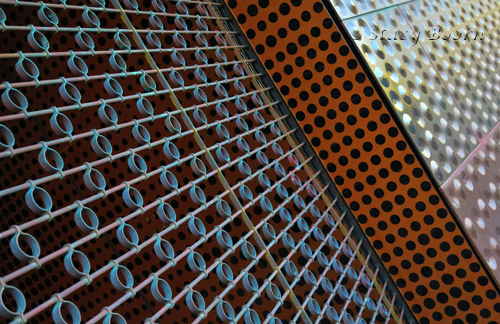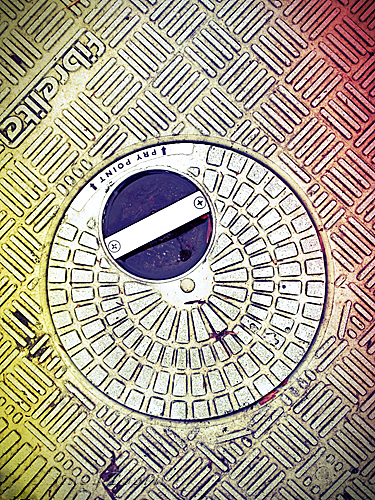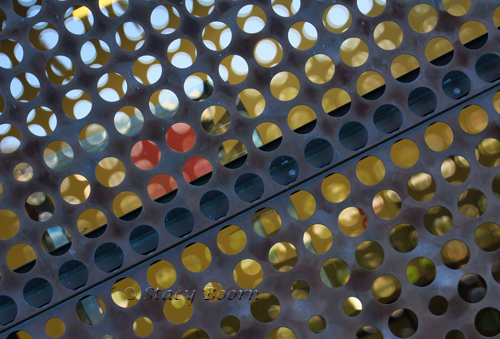
Detail of the deYoung Entrance
I have only taken one drawing/painting class. That was when I was at Central Park Junior High School in Schenectady, New York. I was in the eighth grade, and I must confess I do not remember much of the class, not even the teacher’s name or what she looked like. But I do remember her very first words: “After you learn to draw a circle and a straight line you can do anything.â€
Under her tutelage, we practiced over and over again the twist of the wrist for a circle and then a swish of the wrist for a line. Each student filled up pages with circles and lines until we almost perfected them.

Gas Station Tank Cover
My only other art courses were in college: art history, art appreciation, and ceramics. Art appreciation was a wonderful class. My college was located in Bronxville, New York, just a short, inexpensive (at that time) train ride into New York City. So the Museum of Modern Art, the Guggenheim Museum, and the Whitney, just to mention a few, were the extensions of our classroom work. My favorite artist became sculptor Alexander Calder whose huge mobiles of colorful circles attached to black lines which from the ceiling of MOMA’s largest exhibit hall.
Many artists made contour line drawings on paper, but Calder was the first to use wire to create three-dimensional line “drawings” of people, animals, and objects. He introduced line into sculpture as an element unto itself. Later Calder shifted from figurative linear sculptures in wire to abstract forms in motion by creating the first mobiles. Composed of pivoting lengths of wire counterbalanced with thin metal fins the entire piece was randomly arranged and rearranged in space by the air moving the individual parts.
To this day, thanks to that eighth-grade class, I love images that have circles and lines in them. To some extent all images have circles and lines in them. But those great abstract images that deliberately juxtaposition circles and lines seem to be filled with endless interpretations.

deYoung Museum exterior detail – lights on inside.
Many years later when I was reflecting on that mantra of my eighth-grader teacher, “a circle and a straight line,” I have come to believe that her instruction was far more reaching then drawing those shapes. She was talking about philosophies, ways of thinking, cultural paradigms and life styles.
Linear and circular thought patterns are often seen as polar opposites. But perhaps they can be partners in creating new ways of being as they were on those sketch pads in eighth grade. Each of these modes has a set of operating conditions that are intuitively different.

Knots and Grain -Circles and Lines
Scientists often think linearly while artists think circularly; men on average lean towards linear thinking while women are more circular. Aboriginal people traditionally think in circles while westerners tend to think linearly; patriarchal religions present their dogma linearly while goddessians create community circularly.
Linear thinking is considered logical, objective, disciplined, and goal oriented, all in order to push back against the dangers fear has identified for us.  Perhaps this way of thinking provides for our survival. Circular thinking is rooted in a drive to be inclusive and transparent – a belief that the answer will come when everyone shares their innate wisdom, and a diverse array of thoughts are considered and integrated. Without circular thinking we could not change, feel contentment or develop relationships.
A circle and a line – toiling together rather than in opposition; it might just work! It certainly does in the “skin†of the deYoung Museum in Golden Gate Park.
